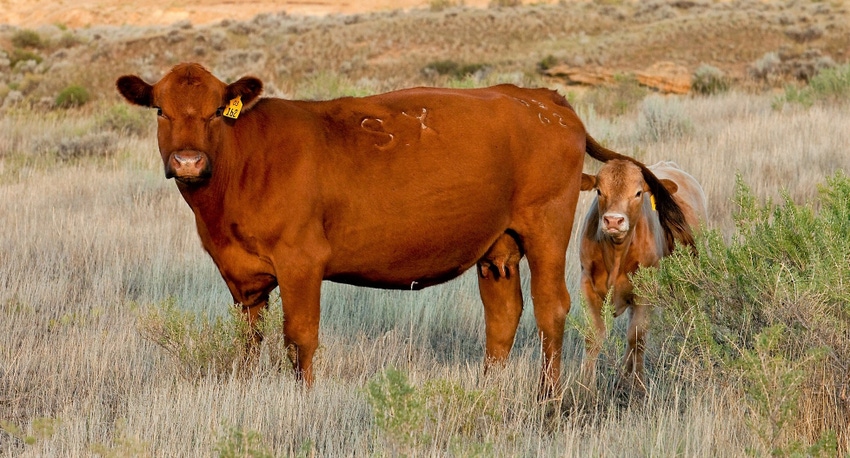August 26, 2021

Drought continues across the American West, forcing producers to consider alternative management strategies for their cattle herds. One option to mitigate drought stress on cows is to wean their calves early. Early weaning allows cows to stop lactating and improve their body condition prior to re-breeding. Additionally, removing calves from the cowherd reduces grazing pressure on pastures.
“This year, in severe drought, many producers are almost out of pasture,” says Megan Van Emon Montana State University Extension Beef Specialist. “A 500-pound calf eats about 15 pounds of pasture a day. Multiple by 100 calves, and that’s 1,500 pounds per day. Weaning calves early and removing them to a backgrounding lot or selling them, can help you hold the cows longer on the pasture that you have left.”
Van Emon says that a lactating cow typically consumes 2.5 percent of her body weight per day. “There will be a 30% reduction in feed demand once she stops lactating – down to 2% or less of her body weight per day,” she continues. “Let’s say she’s a 1,400-pound cow and eating 35 pounds a day lactating, she’ll drop to 30 pounds a day once weaned from her calf.”
Early weaning is a strategy for managing cows in a drought, because it removes nutrient demand from cows. This allows them to allocate resources just for themselves, and rebreed at a higher rate. “Early weaning may decrease the number of poor condition and open cows that result from heat stress and dry forage conditions,” says Matthew Garcia, Utah State University Beef Cattle Specialist. “This will maintain the cowherd in better shape for next year.”
Early weaning options
When early weaning, there are several ways to handle the calves once removed from the mother cows. First, decide at what age to wean the calves. Van Emon recommends that 80 days be the lowest age of weaning. “When younger than 80 days,” she says, “the calves don’t have a fully functioning rumen yet and rely a lot on milk from the cows.”
Before early weaning, Garcia advises analyzing the cost benefits of backgrounding versus immediately selling the calves. “When penciling it out,” Garcia says, “instead of spending extra money and feed resources you may not have on pre-conditioning or backgrounding calves, you may come out ahead selling early-weaned calves. For instance, you may hit the market with those calves before other ranchers sell at traditional times and then receive a higher price.”
Calves, around the 5-to-6 month old age, are more of a risk to the buyer. “Younger calves are more likely to become sick during transport and going through the sale barn,” Van Emon says. “It is often harder to bunk train them and they’re fence crawlers, because feedlots are built for 500-pound and heavier calves.” Most cow/calf producers aren’t set up to pre-condition or background young calves themselves, though.
Related: Some ranchers use nose flaps for low-stress weaning
“In the beef industry, we’re in a linked system,” Garcia says. “We have the cow/calf or seedstock, the stocker, the feedlot guys, and the packers. The behavior of the producers affects the whole system. We know that weaning is one of the most stressful periods for calves. When early weaning, we add more stress to them and that affects their performance in the feedlot.” Even so, early weaning may be essential for cow/calf producers to maintain their cowherds during drought.
Management strategies change as droughts lengthen. In the first year of drought, with stable commodity market prices for cattle, it may make financial sense to pre-condition early-weaned calves. It is healthier for the calves. They will transition to the feedlot more smoothly and gain weight at a faster pace. By the third year of drought, though, pre-conditioning early-weaned calves may be unfeasible.
“Let’s say it costs 10 cents a pound to pre-condition a 400-pound calf,” Garcia figures. “It will total $60 per calf. What’s the return on investment? I may get $1.40 per pound for the pre-conditioned calf when I sell it. Another guy, who didn’t pre-condition, may get a $1.15 per pound. It’s important to project if the increased production cost actually increase the return on investment in a calf.”
As drought forces cattle management — such as early weaning — that you’d normally woudn’t consider, thoughtfully review the status of: available feed resources, body condition of the cows, and age of the calves. Compare these to the production costs, projected return on investment for the calves, and the drought forecast. Base herd management decisions on the current events, as well as how you would like your operation to be positioned when the drought recedes.
About the Author(s)
You May Also Like




